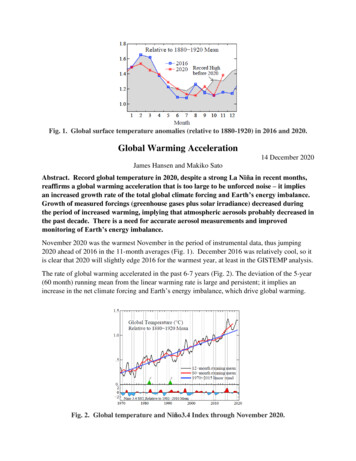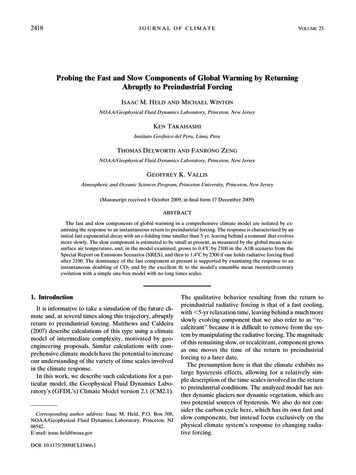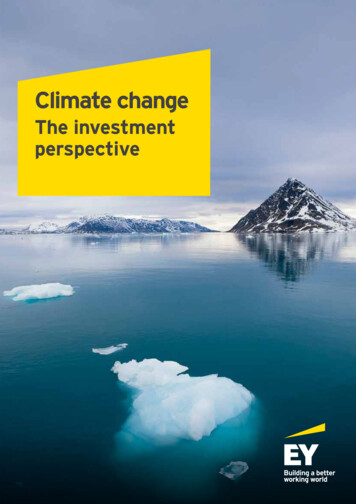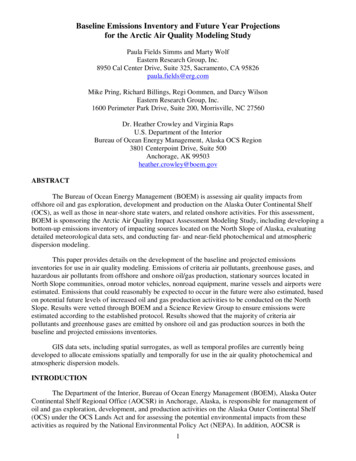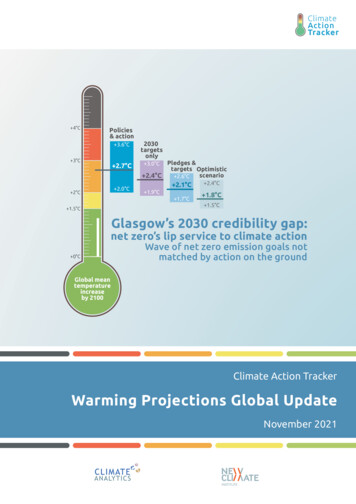
Transcription
ClimateActionTracker 4 CPolicies& action 3.6 C 3 C 2 C 2.7 C 2.0 C2030targetsonlyPledges &targets Optimisticscenario 2.4 C 2.6 C 3.0 C 2.1 C 1.9 C 1.7 C 1.5 C 2.4 C 1.8 C 1.5 CGlasgow’s 2030 credibility gap:net zero’s lip service to climate action 0 CWave of net zero emission goals notmatched by action on the groundClimate Action TrackerWarming Projections Global UpdateNovember 2021
SummaryIn Paris, all governments solemnly promised to come to COP26, with more ambitious 2030commitments to close the massive 2030 emissions gap that was already evident in 2015. Threeyears later the IPCC Special Report on 1.5 C reinforced the scientific imperative, and earlier thisyear it called a climate “code red.” Now, at the midpoint of Glasgow, it is clear there is a massivecredibility, action and commitment gap that casts a long and dark shadow of doubt over the netzero goals put forward by more than 140 countries, covering 90% of global emissions.Policy implementation on the ground is advancing at a snail’s pace. Under current policies,we estimate end-of-century warming to be 2.7 C. While this temperature estimate has fallensince our September 2020 assessment, major new policy developments are not the drivingfactor. We need to see a profound effort in in all sectors, in this decade, to decarbonise theworld to be in line with 1.5 C.Targets for 2030 remain totally inadequate: the current 2030 targets1 (without long-termpledges) put us on track for a 2.4 C temperature increase by the end of the century.2 Since the April2021 Biden Leaders’ Summit, our standard “pledges and targets” scenario temperature estimateof all NDCs and submitted or binding long-term targets has dropped by 0.3 C to 2.1 C, but thisimprovement is due primarily to the inclusion of the US and China’s net zero targets, now that bothcountries have submitted their long-term strategies to the UNFCCC.Policies & actionReal world action based on current policies2030 targets onlyFull implementation of 2030 NDC targets*Pledges & targets 4 C 3.6 C 3 C 2 CFull implementation of submitted and bindinglong-term targets and 2030 NDC targets*Policies& action 2.7 C 2.0 COptimistic scenario2030targetsonlyPledges &targets Optimisticscenario 2.4 C 2.6 C 3.0 C 2.1 C 1.9 C 1.7 C 1.5 C 0 CIf 2030 NDC targets are weaker than projected emissions levelsunder policies & action, we use levels from policy & action 2.4 C 1.8 C 1.5 C1.5 C PARIS AGREEMENT GOALWE ARE HERE1.2 C Warmingin 2021Best case scenario and assumes fullimplementation of all announced targetsincluding net zero targets, LTSs and NDCs*CAT warming projectionsGlobal temperatureincrease by 2100November 2021 UpdatePRE-INDUSTRIAL AVERAGE1For weak targets, we take a country’s estimated 2030 level under current policies, if that level is lower than the target.2Normally, the CAT bases its temperature estimates on all binding targets, including both 2030 and longer-term net zero targets; however,as more and more countries adopt their net zero targets in domestic law or submit long-term strategies to the UNFCCC, we felt the needto include this new temperature estimate to highlight the growing credibility gap between targets in 2030 and net zero targets for 2050or later.Climate Action Tracker Warming Projections Global Update - November 2021i
There has been insufficient momentum from leaders and governments to increase 2030 climatetargets ahead of, and at, Glasgow: NDC improvements submitted over the last year have reducedthe emissions gap in 2030 by only 15-17%. The biggest absolute contributions to this narrowingcome from China, EU and the US, though other countries with lower emissions levels have alsoimproved their NDCs.Contrary to the Paris Agreement’s requirement that each NDC update is a progression beyond thelast, several governments have only resubmitted the same target as 2015 (Australia, Indonesia,Russia, Singapore, Switzerland, Thailand, Viet Nam), or submitted an even less ambitious target(Brazil, Mexico). Some have not made new submissions at all (Turkey and Kazakhstan), and Iranhas yet to ratify the Paris Agreement. Even with all new Glasgow pledges for 2030, we willemit roughly twice as much in 2030 as required for 1.5 . Therefore, all governments need toreconsider their targets.Globally, around 90% of emissions are now covered by net zero targets. While these targetsare an important signal, and some have accelerated governments’ climate action, the quality ofmost remains questionable. If all the announced net zero commitments or targets under discussionare implemented, this would bring our temperature estimate for this “optimistic scenario” down to1.8 C by 2100, with peak warming of 1.9 C. But this is only IF these targets are fully implemented,and it’s a big IF. Our analysis, covering 40 countries, shows only 6% of global emissions are coveredby targets with an “acceptable” net zero rating for target comprehensiveness.No single country that we analyse has sufficient short-term policies in place to put itself on track to itsnet zero target. The net zero CAT assessment also includes announcements made by governmentswhich are not backed up by any national legislation, nor plans. Some lack critical information to allowfor a full evaluation of the target’s likely impact, including whether net-zero is defined as CO2 onlyor covers all greenhouse gases. It also needs to be emphasised that our ‘optimistic’ assessmentof end-of-century median warming of about 1.8 C is not Paris Agreement compatible and thatwarming of 2.4 C or more cannot be ruled out.2030 actions and targets are more often than not inconsistent with net zero goals, sothat the gap between current policies and net zero goals is now 0.9 C. This, we consider, is thecredibility gap that Glasgow needs to address.The key drivers for this appalling outlook are coal and gas.CoalTo meet the Paris Agreement’s 1.5 C warming limit, coal must be phased out of the powersector by 2030 in the OECD, and globally by 2040. But in spite of political momentum and clearbenefits beyond climate change mitigation, there is still a huge amount of coal in the pipeline,for example in China, India, Indonesia and Viet Nam, and too many countries, includingJapan, South Korea, Australia, still have plans centered around coal as a major contributor toelectricity generation in 2030. Some also continue funding coal projects abroad. While someof these governments have committed in Glasgow to phasing out coal, we need to see thatreflected on the ground at home.Natural gasThe increasing use of natural gas is not Paris Agreement compatible, yet we are seeing thegas industry push and promote their product, supported by governments across the world. Inthe six years since the Paris Agreement, CO2 emissions from gas grew by 9%, whereas emissionsfrom coal and oil are down. Gas for electricity generation, as with coal, needs to peak in thisdecade, and largely be phased out globally in the coming decades, and for other applicationsClimate Action Tracker Warming Projections Global Update - November 2021ii
soon after, if the world is to reach net zero CO2 by 2050. In Southeast Asia, heavily coal-dependent countries are now considering a switch from coal to gas (e.g. Viet Nam), rather than directlyto renewables, large infrastructure for natural gas is also under development in Europe (NordStream 2 for imports from Russia), Canada (expansions of pipelines for export), Australia andthe USA (LNG exports), and multiple African countries are promoting the increased productionand use of natural gas.Methane and forestryGlobal methane and forestry initiatives announced in Glasgow support important actions,but these must go beyond existing national targets to be impactful: the Global MethanePledge – of reducing methane emissions by 30% in 2030 – has the maximum potential to reducethe 2030 emissions gap by 14%, and warming by -0.12 C by 2100. But much of this potential isalready included in existing climate pledges. The US is a prime example: the methane reductiontarget is already partially included in its long-term strategy, which we have already includedthe effect of in our ‘Pledges and Targets’ temperature estimate. Similarly, the Global ForestryFinance pledge can result in additional climate mitigation only if this finance is additional tothe current promised funding and does not cut funding for other mitigation measures. Sincethe USD 100bn goal has not yet been met, the additionality of this new initiative is questionable, at best.Glasgow must address the credibility gapWhile the warming outlook has improved since Paris, the bottom line is that despite all the net zeropromises, inadequate real-world action unable to deliver the kind of climate action that is alignedto the 1.5 C temperature limit: in 2015, ahead of the Paris Agreement, the CAT estimated currentpolicies would lead to warming of 3.6 C, and the submitted targets (NDCs) would lead to 2.7 C. Sixyears later, the warming from current policies has now come down to 2.7 C. If governments were toachieve their 2030 NDC targets and binding long-term targets (LTS), temperature increase could belimited to 2.1 C.If governments are serious about the Paris Agreement’s temperature limit and their own net-zerogoals, they need to translate those long-term goals into net-zero aligned ambitious 2030 targetsand implement the necessary policies today. Developed countries will also significantly increasethe climate finance available to support the transition. Until this happens, there is no cause forcelebration.Climate Action Tracker Warming Projections Global Update - November 2021iii
Table of ContentsContentsSummary i12030 targets are totally inadequate and put achieving 1.5 C at risk 12NDCs updates are not in line with the Paris Agreement 33Implementation gap is growing – and doing better is not enough 64Sector and gas initiatives must go beyond existing national targets to be impactful 85Net zero targets – inching closer to 1.5 C – but credibility is questionable 86Warming outlook has improved since Paris 127Country snapshots 13Annex 17A1Scenario definition 17A2Detailed overview of net zero target assessments 19A3Optimistic Temperature Estimate Assumptions 21A4Differences between Climate Action Tracker,UNFCCC Synthesis Report & UNEP Gap Report 28Climate Action Tracker Warming Projections Global Update - November 2021iv
12030 targets are totally inadequate and put achieving 1.5 C at riskThe IPCC has set clear benchmarks. To keep the possibility of 1.5 C alive, we need to cut emissions by45% below 2010 levels by 2030, in other words, halve emissions from present levels by then.50Emissions gap in 2030 for 1.5 C2030 Emissions gapPledges& TargetsCAT projections and resultingemissions gap in meeting the1.5 C Paris Agreement goalChanges from Sept 2020 to Nov 2021CHANGE40Historicalincl. LULUCF30ClimateActionTracker20199019951.5 C Paris Agreement compatible20002005NewOld2010201520202025New NDCs todate narrow thegap in 2030 byaround 3.3–4.7GtCO2eor 15–17%Sept 2020updateParis 1.5 C19 – 23 GtCO2e60Paris 1.5 C23 – 27 GtCO2eGlobal GHG emissions GtCO2e / yearUpdated NDC targets fall short, far short, of meeting this benchmark. The 2020/2021 round of NDCupdates has only reduced the emissions gap in 2030 by 15-17%. Even after the new update round,global emissions in 2030 resulting from implementation of NDCs will still be twice as high as what’sneeded for a 1.5 C consistent pathway. Page width 16cmNov 2021update2030Figure 1 2030 emissions gap between NDC targets and levels consistent with 1.5 C.If just these targets3 are considered, end-of-century warming would be 2.4 C, almost a full degreeabove the Paris limit, at a time when every 0.1 C matters. Normally, the CAT bases its temperatureestimates on all binding targets, including both 2030 and longer-term net zero targets; however, asmore and more countries adopt their net zero targets in domestic law or submit long-term strategiesto the UNFCCC, we felt the need to include this new temperature estimate to highlight the growingcredibility gap between targets in 2030 and net zero targets for 2050 or later (see Figure 2).This credibility gap grows larger when we turn our attention to policy implementation. Under currentpolicies, end-of-century warming will be 2.7 C.4 While this temperature estimate has fallen since ourlast assessment, major new policy developments are not the driving factor. It is also still well aboveour “2030 targets only” temperature estimate, indicating that, collectively, countries are not on trackto achieve the targets they have put forward.3For weak targets, we take a country’s estimated 2030 level under current policies, if that level is lower than the target.4We have updated the data for most of the countries we track since our last assessment in September 2020. See Annex I for details.Climate Action Tracker Warming Projections Global Update - November 20211
16cm2100 WARMING PROJECTIONSGlobal GHG emissions GtCO2e / yearEmissions and expected warming based on pledges and current policiesClimateActionTracker70Nov 2021 update60Warming projectedby 210050Historical40Policies & action 2.5 – 2.9 C2030 targets only 2.4 CPledges & targets 2.1 COptimistic scenario 1.8 C30!20102030ambition gap19–23 GtCO2e01.5 C consistent 1.3 02100Figure 2 Global greenhouse gas emission pathways for CAT estimates of policies and action, 2030 targets only,2030 and binding long-term targets and an optimistic pathway based on net zero targets of over 140 countries incomparison to a 1.5 C consistent pathway.When all NDCs and binding5 long-term pledges are considered (our “pledges and targets” scenario),end-of-century warming would be limited to 2.1 C. While this estimate is 0.3 C lower than our May2021 assessment, the drop is primarily due to the official submissions of the long-term plans of USand China.Expanding our scope to include all net zero targets that have been announced or are currently underdiscussion, including the most recent announcement from India, warming would peak at 1.9 C beforefalling to 1.8 C by the end of the century. While an estimate that comes under the 2 C level is animportant milestone, it must be stressed that this is based on only a 50 / 50 chance that warmingwill indeed be limited to 1.8 C by 2100 and 1.9 C at its peak. While the level of warming in 2100, inprobabilistic terms, is “likely” to be below 2.0 C, the same is not true of the peak level of warming inthis century. But again, we reiterate that according to our analysis, only 6% of global emissions arecovered by, in our analysis, an “acceptable” net zero target.In recent weeks, many different organisations have published estimates of the impact of targetson temperature estimates. While at first glance, the headline figures may appear different, a closerexamination of the underlying methods reveals that these are closely aligned and offer the samegeneral message: 2030 targets are totally inadequate and put achieving 1.5 C at risk (see Annex 4 forfurther details).5We consider targets to be binding if they have been adopted in domestic legislation or submitted, with sufficient clarity, in long-termstrategies to the UNFCCC. We exclude older submissions if we deem that the country has abandoned its target. See Annex I for details.Climate Action Tracker Warming Projections Global Update - November 20212
2NDCs updates are not in line with the Paris AgreementThe majority of countries have submitted NDC updates, but emission cuts in 2030 remain woefullyinadequate.With the announced update from India, more than three-quarters of countries, representing nearglobal emissions coverage (over 95%) and close to 90% of the population, have announced orsubmitted updates. Turkey is the only G20 country to not have submitted an update, having onlyratified the Paris Agreement in October 2021.While the number of NDC updates is high, the quality of the submissions varies greatly, with a greatmajority not raising ambition enough, and, in several cases, not raising ambition at all.IMPROVEMENTSSince our last update in May, some countries have submitted stronger targets, with a fewgoing beyond their initial announcements.SOUTH AFRICA heeded the call of its Presidential Climate Commission and submitted astronger NDC target in September 2021 than it had originally proposed earlier in the year.The bottom end of this range is knocking on the door of 1.5 C compatibility.MOROCCO strengthened its NDC targets in June 2021, its unconditional target is 1.5 Ccompatible, while its conditional target, for which it will need support to meet, is withinstriking distance of the 1.5 C limit.UKRAINE also submitted a stronger target, adopting the bottom end of the range itoriginally announced in December 2020. It still has some way to go to be 1.5 C compatible,but if the Ukraine fully implements all the policies it has planned, it could exceed itsupdated target.ARGENTINA submitted the slightly stronger it announced at Biden’s Leaders’ Summit inApril 2021. With this strengthening, Argentina’s domestic target is now compatible with a2 C world, but it is still far off from 1.5 C compatible or doing its fair share.NEW ZEALAND’S new target appears to be continuing with its long history of creativeaccounting tricks that obscure its effective reductions, and it is still far from doing its fairshare.CANADA and JAPAN have officially submitted the targets they announced at Biden’sLeaders’ Summit: while both domestic targets are getting closer, they still fall short of 1.5 Ccompatibility.CHINA officially submitted the stronger targets it had announced last year. While animprovement, these targets are still within the expected emissions level in 2030 undercurrent policies, meaning that China can achieve these targets without further measures.China has yet to commit to a peaking year for carbon dioxide emissions before 2030, norset absolute emission reduction targets, which leads to uncertainty around its emissionstrajectory to 2030. It is also far off a 1.5 C compatible pathwaySOUTH KOREA announced a stronger NDC target during the Glasgow World Leaders Summit.This announced domestic target has halved the distance to becoming 2 C compatible, but itis still far off from 1.5 C compatible or doing its fair share.Climate Action Tracker Warming Projections Global Update - November 20213
UNCERTAINFor others, it has been harder to assess whether the targets are stronger, given the lack ofdetails.INDIA announced updated NDC targets during the World Leaders Summit, but providedfew details. Its new intensity target is unlikely to have any real-world effect, as it falls aboveIndia’s likely 2030 emission level under current policies, while its 500GW non-fossil targetwill, at most, have a small impact on real-world emissions. Prime Minister Modi promisednet zero by 2070, but did not mention any plans to phase out coal, despite having one ofthe highest coal capacities and pipelines in the world. Recent CAT analysis shows the earlyretirement of the existing capacity and a reduction of its pipeline could enable India to meetits fair share and save a quarter of a million premature deaths.SAUDI ARABIA has submitted an updated NDC with a seemingly stronger target, althoughit is difficult to assess this, as it has not communicated the baseline emissions upon whichthe reduction is based. The updated NDC retains its ‘escape clause’: the emissions reductionpledge is contingent on continued and significant oil and gas exports, without which SaudiArabia reserves itself the right to revisit its target.UNCHANGEDUnfortunately, it is quite clear that the laggards are still lagging.AUSTRALIA resubmitted its 2030 target unchanged. It claimed that this will be exceededby up to 9%. The Paris Agreement requires countries to increase their ambition with eachupdate: claiming that you will overachieve your target without actually committing to astronger target does not cut it. Based on our assessment of current policies, the governmentmay meet the lower bound of its 2030 target, but not overachieve it. Australia’s new 2050net zero target is also questionable (more on that in the net zero section below).BRAZIL continues to obfuscate with creative accounting tricks. While the headline reductiontarget has increased from 43% to 50%, changes in the baseline mean that this target is stillless ambitious than the first NDC on an absolute basis. As of 4 November 2021, Brazil hadalso not submitted this update to the UNFCCC. MEXICO did a similar thing with its updatelast year.INDONESIA submitted an updated NDC in July 2021 but did not strengthen its 2030target. It now joins the “submitted the same or a weaker target” club, along with RUSSIA,SINGAPORE, SWITZERLAND, THAILAND and VIET NAM, contrary to the Paris Agreement’srequirement that each NDC must result in lower emissions than its predecessor.TURKEY finally ratified the Paris Agreement on 11 October 2021 at which time it officiallysubmitted its 2015 INDC to the UNFCCC. This target is very weak and Turkey has been ontrack to overachieve it for some time. It needs to submit a much stronger updated target.IRAN has still not ratified the Paris Agreement, nor updated its 2030 target.KAZAKHSTAN has still not submitted an update target.Climate Action Tracker Warming Projections Global Update - November 20214
Change in global GHG emissions GtCO2e / yearFigure 3 Status of NDC updates as of 5 November2021.See16cmour Climate Target Update Tracker page for furtherwidthLONGERPageVERSION- 13 COLUMNSdetails.Impact on the 2030 emissions gap from NDC updates10-1Changes from September 2020 to November 2021UkraineArgentina EU-2-3-4-5TotalClimateActionTrackerTotal change in the 2030emissions gap from NDC updates3.3–4.7 GtCO2e or a15 %–17 % decrease. A gap of19–23 GtCO2e remains.USAOther * Brazil* Other changes from NDC updates or methodological changes When the comparator is to current policies, we use our most recent assessment-6Figure 4 Impact of NDC updates since September 2020 on the reduction in the 2030 emissions gap.Figure 4 shows the changes in contribution to the emissions gap since last September, while this hasimproved since our May 2021 update.6 At the end of the day, the gap remains substantial.6While we are not able to track all countries, we have improved our methods in relation to emissions estimates for non-CAT countries. Partof the change is due to NDC updates and part is due to methodological improvements: we used the quantified NDC for over 100 countriesbased on the mitiQ tool provide by the Potsdam Institute for Climate Impact Research and updated the baseline of the remaining countriesbased on the newest PRIMAP baselines. These changes are also reflected in the waterfall graph.Climate Action Tracker Warming Projections Global Update - November 20215
3Implementation gap is growing – and doing better is not enoughWhile our estimate of temperature warming based on real world action has fallen, the pace is still notfast enough to achieve the Paris Agreement temperature goal and countries are risking a lock-in incoal and gas infrastructure.CoalKicking the coal habit should be on the top of everyone’s policy agenda. Globally, we needto phase out coal-fired power generation by 2040, and by 2030 in developed countries, tokeep the Paris temperature limit within reach. The COP26 presidency supports those targetsthrough the Powering Past Coal Alliance, and has set accelerating the transition from coal toclean power as a key objective for COP26. Before and during Glasgow, multiple countries havestrengthened or announced coal phase-out targets and other initiatives, including the first ofits kind partnership to support the transition in a developing country away from coal, the JustEnergy Transition Partnership of UK, EU, Germany, France and South Africa.Phasing out coal has a number of benefits beyond climate protection. CAT analysis shows thatfaster coal plant retirements and reducing the new plant pipeline could avoid hundreds ofthousands of premature deaths in the next decade in India and Indonesia alone. If India wereto eliminate its coal pipeline and retire plants 18 years or older, it would reduce emissionsenough to be making its fair share contribution to climate change. Electricity generation withexisting coal-fired power plants is very often more expensive than building new renewableenergy, calling into question the economic sensibility of new coal plants.Despite the political momentum and clear benefits beyond climate change mitigation, thereis still a huge amount of coal in the pipeline, for example in China and India. And too manycountries still plan for coal to be a major contributor to electricity generation in 2030 (e.g.Japan 19%, South Korea 30%), although they have revised their energy sector planning. Somecountries also continue to fund coal projects — public money spent on infrastructure at riskof becoming a stranded asset. China tops the list of countries financing coal projects internationally (but has announced it will stop doing so), followed by Japan, Czech Republic, Russia,and South Korea.Natural gasThe increasing use of natural gas is not Paris Agreement compatible, yet we are seeing thispushed and promoted by the gas industry and supported by governments across the world.While, for example, Chile’s progress to reduce coal-fired power generation is remarkable, it isnot enough for 1.5 C. Chile’s plans for retrofitting include the option of switching to naturalgas. Gas reduces the emissions intensity compared to coal, but risks locking in higher emissionslevels than required for 1.5 C, and increases dependency on energy imports. Gas for electricitygeneration, similarly to coal, needs to largely be phased out globally in the coming decades.We are seeing similar developments in Southeast Asia, where heavily coal-dependent countriesare now considering a switch from coal to gas, next to expanding renewables. Large infrastructure for natural gas is also under development in Europe (Nord Stream 2 for imports fromRussia), Canada (expansions of pipelines for export), and USA (LNG exports), and multipleAfrican countries are promoting the increased production and use of natural gas (e.g. Nigeria).The recent gas price hikes in Europe illustrate the vulnerability of gas dependence. The answerto such a crisis is building up renewable energy and improving energy efficiency, actions thatcontribute to a sustainable pathway in the long term and are, to a large extent, independentof geopolitical developments - not the further expansion of gas infrastructure to improve thesupply.The CAT had already warned in 2017 about relying on gas in the transition towards 1.5 Cpathways. Since then, research has become even clearer on the required decrease of the roleof gas and the associated risks of investing in gas infrastructure, including the limitations ofrepurposing gas infrastructure for green gases later on.If governments are serious about the Paris Agreement’s temperature limit and their own netClimate Action Tracker Warming Projections Global Update - November 20216
zero goals, they need to realise what those long-term goals require in terms of short-termaction, to guarantee the least disruptive pathway possible. Increasing ambition for 2030follows naturally from such considerations.Climate financeTo accelerate implementation globally, and ensure that all countries benefit from the transitionto 1.5 C, developed countries need to massively increase international climate finance.Sufficient climate finance is critical to ensure that developing countries are able to meet theirtargets. None of the developed countries the CAT tracks have put forward sufficient climatefinance (Figure 5). Recent analysis shows that the USD 100bn goal will only be met in 2023.While the goal is projected to be met around 2023, the anticipated level of USD 113-117bn in2025 is still far below what would represent a fair contribution, but also what is needed. TheJust Energy Transition Partnership for South 16cmAfrica is a promising development, while detailson the terms and quality of the financing are still UzzJAPANNEW pt2021Updatezzzzzzzzz based on levels of internationalzRatingsz finance for emissionszreductionsFigure 5 CATof developed countries.z climate finance ratingszzzzEliminatingzzofzzfossilzCLIMATEzFINANCE RATINGSzzzzzzzdevelopmentszthe provisionfinance forfuelinternationallygoeshand-in-handwith increasingworldzz climate finance,zand stopping fossilz fuel subsidies. Thezalready hasis neededz if we arez suffic
Updated NDC targets fall short, far short, of meeting this benchmark. The 2020/2021 round of NDC updates has only reduced the emissions gap in 2030 by 15-17%. Even after the new update round, global emissions in 2030 resulting from implementation of NDCs will still be twice


